Princess Diana’s tragic passing 25 years ago severely irked the people, despite Queen Elizabeth II’s efforts to shield Princes William and Harry.
The royal family of Britain has owned Kensington Palace for more than 400 years, and it is not without its share of specters.
The spirit of Princess Diana, one of the most well-known people of the 20th century, is most palpably still present, and will continue to do so for as long as her tale is still relevant. And there are currently no indications that its grip on people’s hearts and minds is about to lessen.
A statue of Diana, who would have turned 60 last year, guards the palace’s Sunken Garden. Her sons, Prince William and Prince Harry, who were once as thick-as-thieves and made increasingly few public appearances together, dedicated the statue on her behalf.
It has already been 25 years since Diana was killed in a car accident at the age of 36, leaving behind a complex legacy that means various things to various family members who were forced to carry on and maintain a strong front in the wake of her passing.
Any reluctance to express emotion was viewed by many as disrespectful and an insult to Diana, whom Prime Minister Tony Blair posthumously nicknamed “the People’s Princess” due to the ease with which she interacted with virtually everyone she encountered.
Unmentioned at the time was the fact that the majority of the populace saw Diana as a welcome change from the stuffy behavior of the rest of the royal family, with whom she struggled to establish solid ground and then crossed in numerous ways.
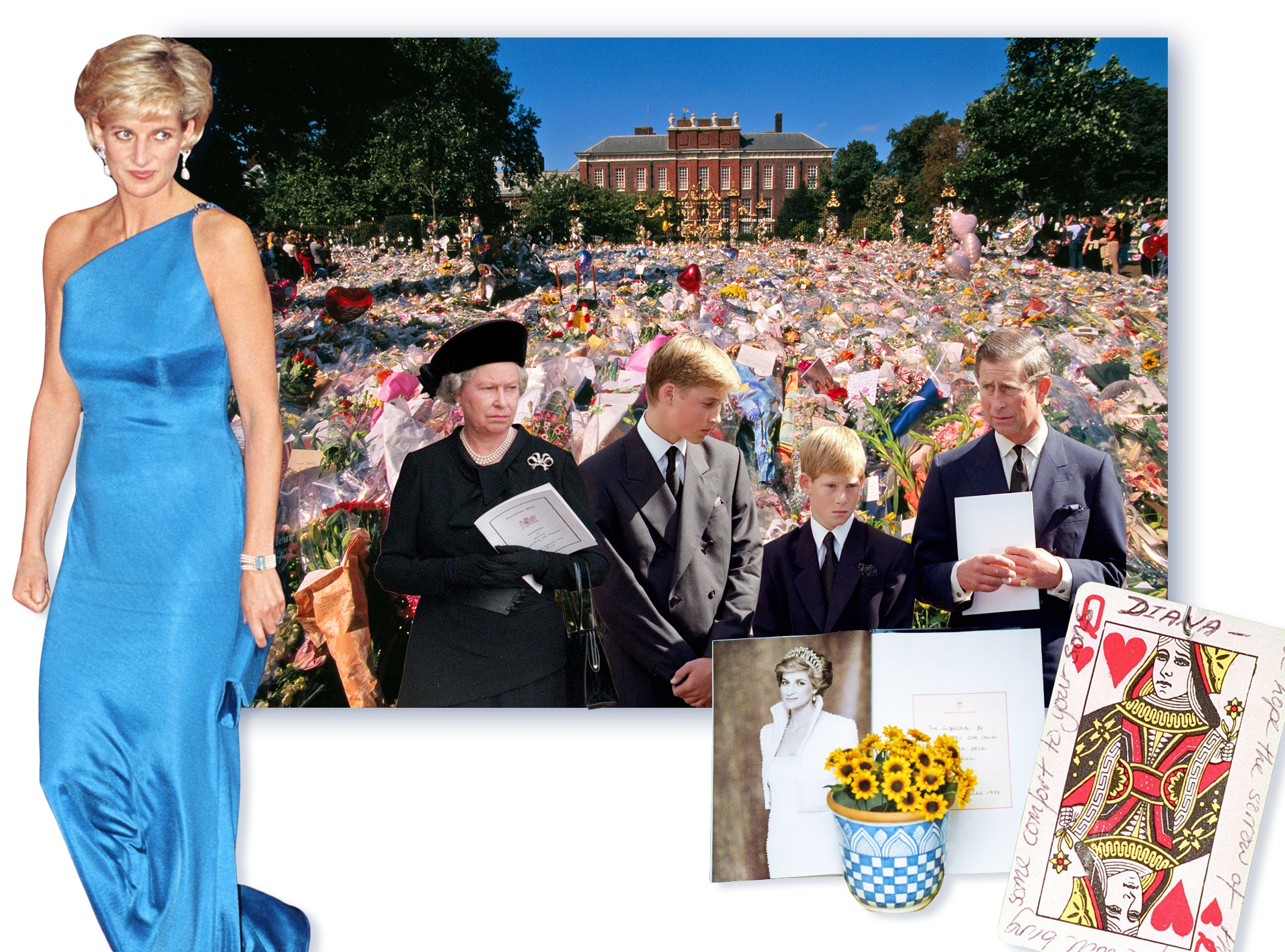
Getty Images; Melissa Herwitt/E! Illustration
One of the few negative points against the monarch that genuinely stuck in the eyes of the general people was the queen’s notorious lack of emotion—or at the very least, insufficient emotion—during the course of the following few days. The royal family will always have its detractors, but the incident in 1997 is still regarded as one of Queen Elizabeth II’s few significant mistakes in the nearly 70 years that she has been in the position of power.
On the front cover of The Express, a headline yelled, “SHOW US YOU CARE.”
When the queen’s private secretary called her at Balmoral Castle in Scotland in the middle of the night to inform her about the tragic crash in Paris, which also claimed the lives of Dodi Fayed, Diana’s boyfriend, and their driver, Henri Paul, she did have more significant matters than public grief to consider, despite the fact that maintaining domestic morale is her specialty. Trevor Rees-Jones, the bodyguard, was the sole survivor.
Ingrid Seward, a royal biographer, wrote in her 2015 book The Queen’s Speech: An Intimate Portrait of the Queen in Her Own Words that the queen was so shocked that she said aloud, “Someone must have greased the brakes.”

Watch: Princess Diana’s Lasting Legacy Lives on Through Her Sons
On August 31, 1997, at 3 a.m., British Summer Time, Diana was declared dead. After calling the Pitié-Salpêtrière hospital for an update, Robert Fellowes, the queen’s private secretary and Diana’s brother-in-law, informed Prince Charles, who was also at Balmoral with William and Harry, that the princess had passed away as a result of her wounds at 4:30 a.m.
“He was in such a terrible state. He broke down, “According to journalist Tina Brown, author of The Diana Chronicles from 2007, Diana: 7 Days That Shook the Windsors is a 2017 television documentary. “He understood right away that this was going to be bad and that…he and they would be held responsible for Diana’s passing.”
“They,” meaning the royal family.
The National Grid claimed a record power surge that was brought on by people turning on their televisions and electric kettles at the same time to brew solace-inducing cups of tea. Every hour, the British national anthem was broadcast. The waiting period for the royal family’s announcement and undoubtedly imminent return to Buckingham Palace started almost immediately.
While London exploded in mourning, the queen remained in Scotland with Diana’s sons.
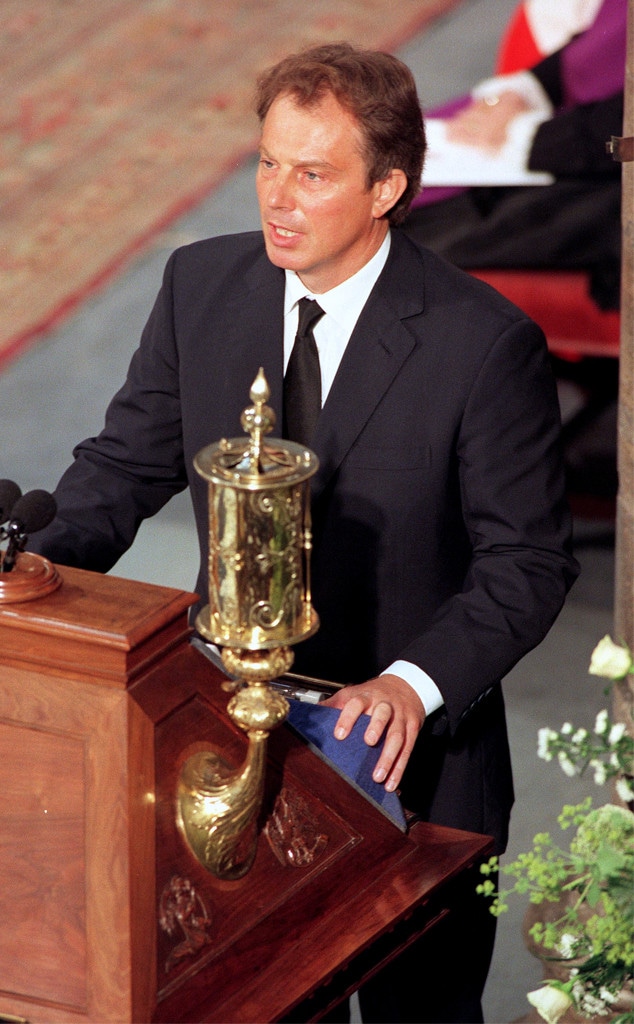
John Stillwell – PA Images via Getty Images
In retrospect, it was a shockingly vulnerable and intimate public act from the head of a country that, as many Britons pointed out wryly or humorously, isn’t known for its friendliness. All eyes were on Blair’s management of his first significant crisis even though he had only been prime minister for a little over four months.
While William and Harry were sleeping, Charles and the queen made the decision to keep William and Harry in the dark about the news.
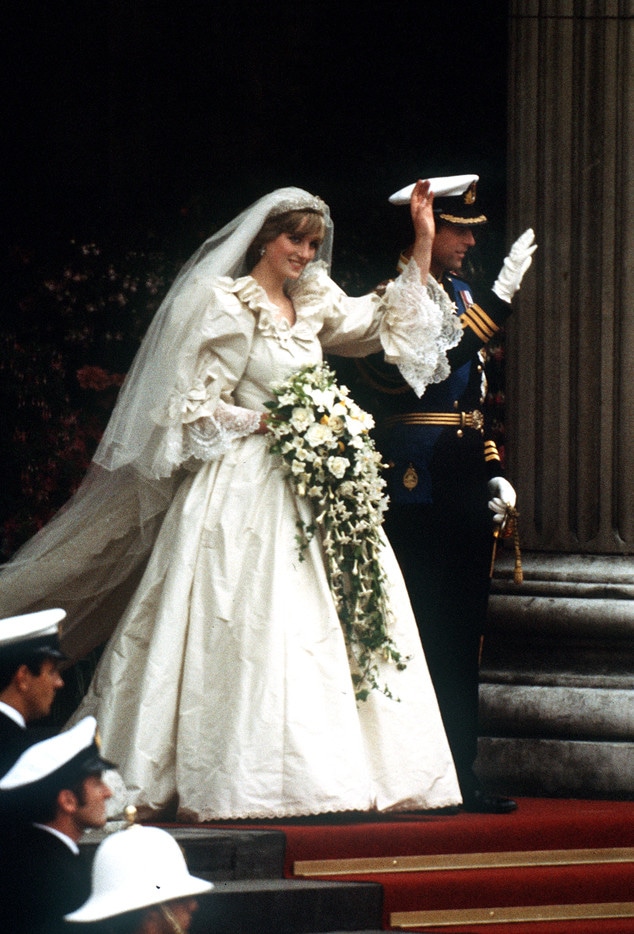
Jayne Fincher/Princess Diana Archive/Getty Images
When he married Diana on July 29, 1981, Charles, who was approximately 13 years her senior and had only spent a small amount of time alone with her previously, found himself in a hazardous situation.
Their divorce had just recently been formalized in 1996, despite the fact that they had been legally separated since 1992 (the queen’s “annus horribilis”). Diana continued to live at Kensington Palace and had access to the royal jet and the rooms at St. James’s Palace for entertaining, while Charles spent most of his time at his Gloucester estate, Highgrove. Diana remained the Princess of Wales but was no longer Her Royal Highness. (Clarence House wasn’t his permanent address in London until 2003.) Equal access to the kids was agreed upon.
Charles, meantime, was eager to fly to Paris in the royal plane to retrieve Diana’s body. According to Diana: 7 Days That Shook the Windsors, the queen originally refused, but Charles persuaded her that it was the appropriate thing to do. The 12-year-old Harry wanted to accompany him, but his father didn’t believe it was a smart idea.

Tim Graham/Getty Images
“Informing your children that your other parent has passed away is one of the most difficult things a parent can do. How you handle that is unclear to me.” Another among the many specials and retrospectives that honored the 20th anniversary of Diana’s passing that year were Harry’s reflections in the 2017 BBC documentary Diana, 7 Days, one of the few produced with the collaboration of her immediate family. “He was there for us, though. He was the lone survivor of the two. He also made an effort to protect and take care of us as best he could. He was, nonetheless, going through the same grief procedure.”
The royal family directed that there be no mention of Diana throughout the service, and Harry and William joined the queen to church that Sunday morning as per custom.
Diana’s sisters, Lady Sarah McCorquodale and Baroness Jane Fellowes, joined Charles in Paris. Charles reportedly said to Michael Jay, the British ambassador to France, in the car as they followed the hearse bringing Diana’s body back to the airport, “It all seems unbelievable.”
Charles had excellent judgment about how Diana should be treated in death, but it didn’t take long for the public to lose faith in the royal family when it became apparent that the queen wasn’t hurrying returning to London.
She and Prince Philip were instead attempting to occupy William and Harry. Others who came to support the princes included Princess Anne, who accompanied her children, Zara Phillips, 16, and Peter, then 19, as well as Charles’ long-retired nanny Mabel Anderson and the boys’ former nanny Tiggy Legge-Bourke.
In the BBC documentary, William, who would later propose to Kate Middleton wearing his mother’s sapphire and diamond engagement ring, recalled that at the time, “you know, my grandma wanted to protect her two grandsons, and my father as well.” “Our grandma purposefully removed the newspapers, and things like that, so there was nothing in the house at all. We therefore had no idea what was happening.”
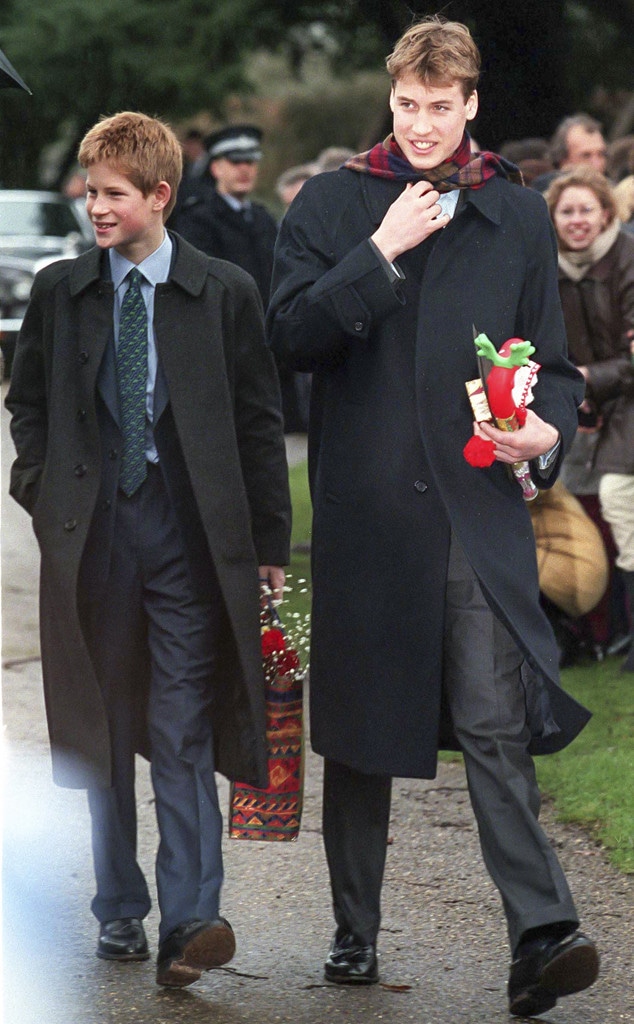
UK Press via Getty Images
William and Diana had a fight not long before she passed away over paparazzi pictures of her and Dodi, the son of Harrods owner Mohamed Al-Fayed, having fun on his family’s yacht. The 15-year-old, who had spent a vacation at Dodi’s house in St. Tropez with his mother and brother, wasn’t a fan. At the time, Harry apparently had no interest in getting to know Camilla Parker Bowles, his father’s longtime lover.
William expressed his gratitude for having “the privacy to mourn, to collect our thoughts, and to simply have that place apart from everyone” in retrospect.
When they eventually made it back to England, father and sons made the unusual decision to fly together, which is typically frowned upon for two future kings. However, the queen gave her approval for the unusual travel arrangements. William remembered that she struggled to balance her job as queen with that of being the grandmother to him and Harry. And I believe that she, as with everyone else, was shocked and taken aback by the scope of what occurred and how rapidly it all occurred.
But the rifts between the public and the royal family that had been growing even before Charles and Diana’s divorce were about to burst into the open.
Earl Charles Spencer, the brother of Diana, delivered a broadcast speech from his house in South Africa, where Diana had briefly considered relocating to carry out her decision to withdraw from public life, which she had confided to a Daily Mail reporter over the phone hours before her death.
But I would say I always thought the press would kill her in the end,” Spencer concluded. Everyone who made money off the illicit Diana images, including editors and publishers, “has blood on his hands today.”
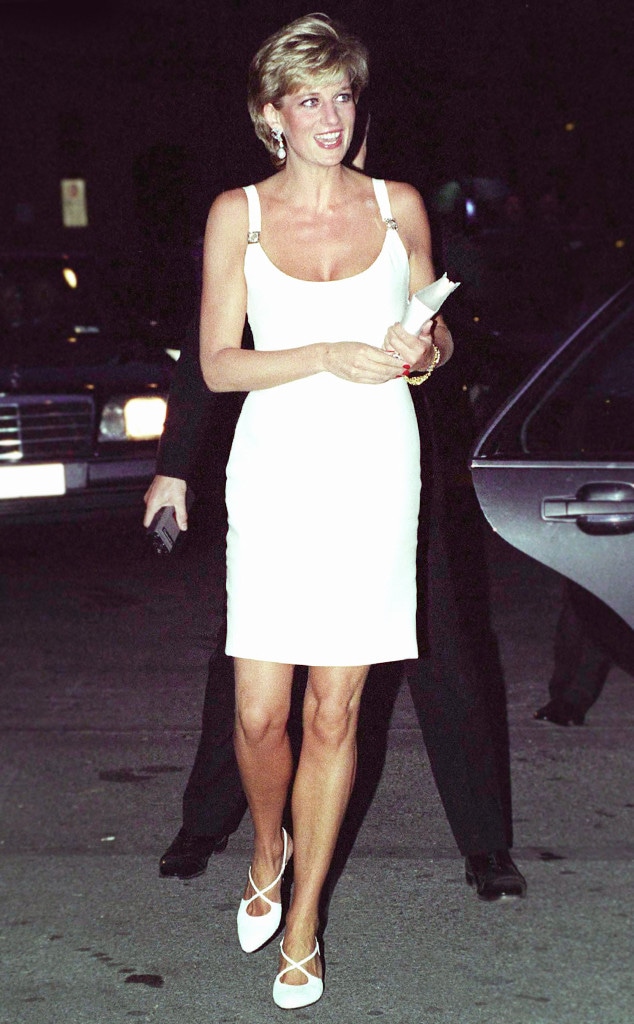
Tim Graham/Getty Images
According to her former press secretary Jane Atkinson, “she had a pretty tetchy relationship with the media,” Vanity Fair said in 2013. There was intense competition for stories, and they had a lot of skepticism for the information they learned from her.
Diana had primarily been attempting to cover up her romance with heart surgeon Hasnat Khan, whom she began dating in September 1995 and was rumored to still be in love with at the time that she also appeared to be getting engaged to Dodi Fayed—when in reality, according to people close to her, she had only been dating the film producer for six weeks and wasn’t particularly serious about the renowned playboy.
Dodi led her to a different one of his family’s homes, the former Windsor villa in the Bois de Boulogne, before they tragically ended up there on August 30. Diana, however, was not in the mood to talk to the ghost of the twice-divorced Wallis Simpson.
In anticipation of the couple’s departure, photographers gathered outside the Ritz, and a select group of them eventually followed their chauffeured Mercedes in a car and on a motorcycle.

JACQUES DEMARTHON/AFP/Getty Images
Harry somberly remarked in Diana, 7 Days, “I think one of the hardest things to come to terms with is that the individuals that chased her, into the tunnel, were the same people that were snapping pictures of her while she was still dying in the backseat of the car.”
When his mother passed away, he was a few weeks shy of being 13 years old. In the five years thereafter, he has opened up to an unprecedented degree about the anger problems he experienced as a result of the tragedy and his ongoing mistrust of (and, quite frequently, hatred at) the media.
Any ill will that the public or the press had ever harbored toward the princess in the last few years of her life was immediately replaced by anger toward the royal family over what was seen as a callous response to the tragedy (some of whom had lost their illusions once Diana revealed that Charles wasn’t the only one who strayed in their marriage).
There was undeniable affection for the missing family as bouquets and improvised memorials covered the grass outside Kensington Palace and individuals could be seen sobbing in the streets, all the while the Royal Standard flag at Buckingham Palace steadfastly remained lowered to half-mast.
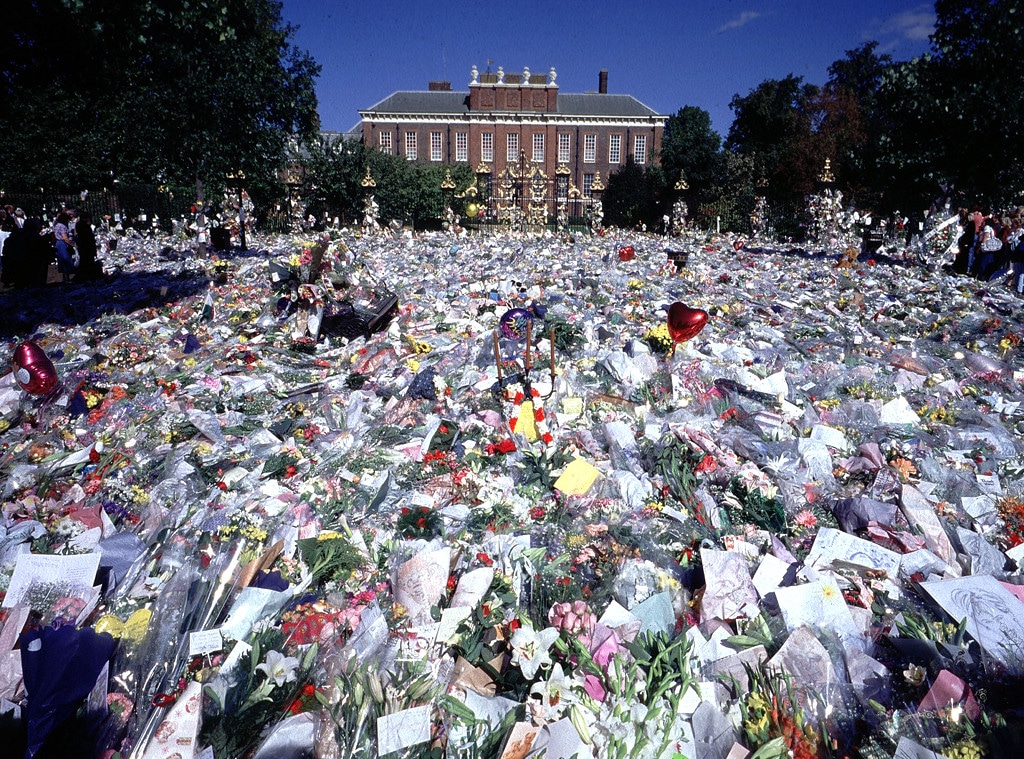
Jeff Overs/BBC News & Current Affairs via Getty Images
Balmoral was affected by the criticism, so on September 4, a Thursday, the queen sent her press secretary to defend the family in a televised message, informing the public that they had been “hurt” by claims that they were “indifferent” to the country’s suffering. The statement stressed that taking care of William and Harry came first.
At the same time, the queen made a concession regarding the flag, allowing the Union Jack to fly at Buckingham Palace for the first time ever—and not simply at half-mast. Prince Andrew and Prince Edward, Charles’ younger brothers, were instructed to go to their parents’ house while being seen by the growingly restless mob loitering outside.
For the first time all week, William and Harry walked outside the Balmoral gates that evening with their father and grandmother to see the collection of flowers and notes.
On Friday, September 5, the day before the burial and one day earlier than expected, the family finally arrived in London. The queen then proceeded to be as forthright with her subjects as she could in her first live broadcast in fifty years.
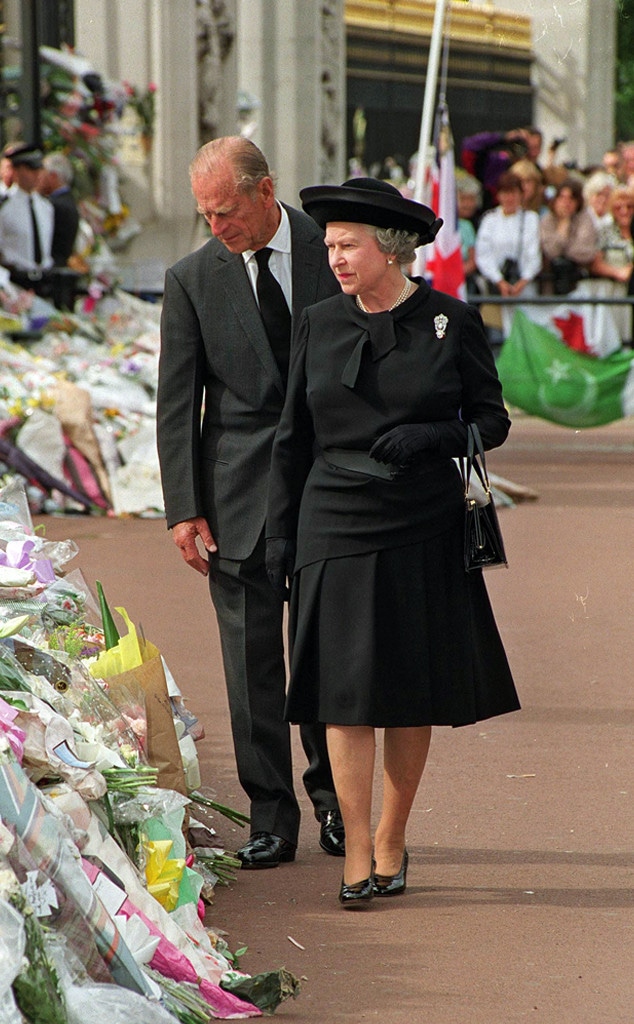
REX/Shutterstock
The queen delivered a national broadcast message from Buckingham Palace while wearing all-black. “Since last Sunday’s tragic news, we have seen throughout Britain and around the world an outpouring display of mourning at Diana’s passing,” she said. “Each of us has been attempting to cope in our own unique ways. Since the first shock is frequently followed by a variety of other emotions, including denial, incomprehension, anger, and concern for those who remain, expressing a sense of loss can be challenging. All of us have experienced those feelings over the past few days. As your queen and grandma, I am speaking to you now from the bottom of my heart.”
“First, I want to pay respect to Diana personally,” the emperor added. She was a unique and talented person. She never lost her ability to laugh and grin, or to uplift others with her warmth and kindness, in good times or bad. She was someone I admired and appreciated for her enthusiasm, dedication to helping others, and especially for her love and care for her two sons. At Balmoral, we have all been attempting to support William and Harry as they process the tragic loss that they and the rest of us have experienced this week.
“Diana will never be forgotten by anyone who knew her. Millions of other people will remember her even though they never met her.
The queen maintained her composure, but her otherwise measured tone revealed tenderness.
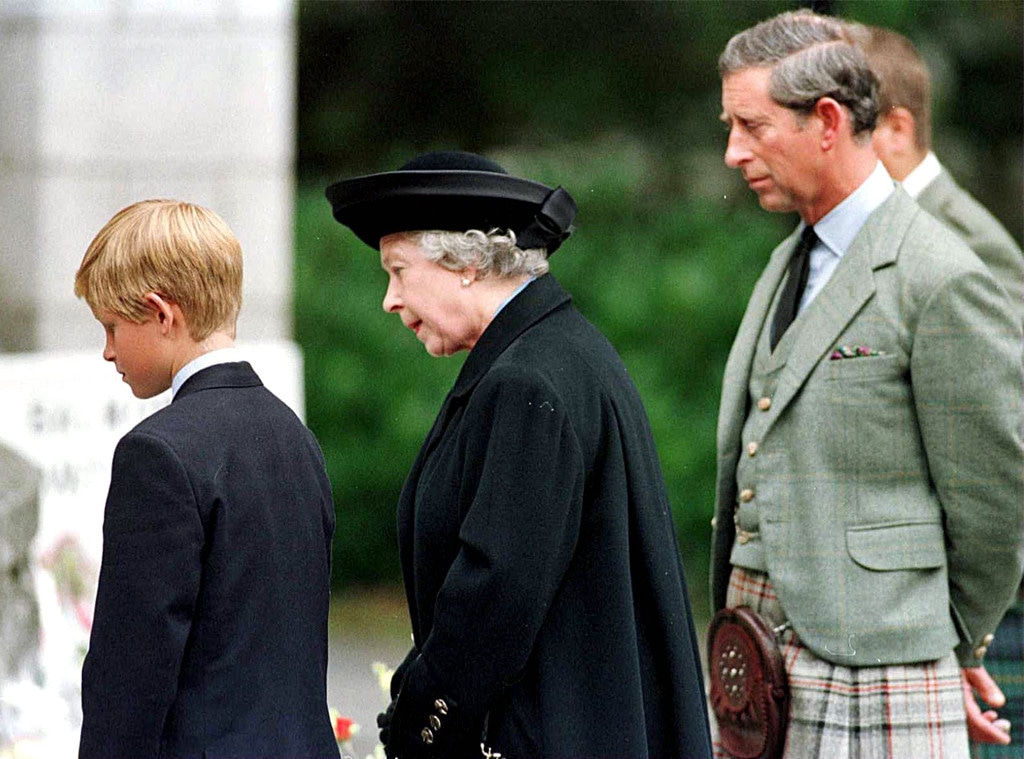
Ian Stewart/REX/Shutterstock
The nation was unified in spirit to pay its respects to the people’s beloved princess on the following day, she hoped, and she also expressed gratitude for the outpouring of solidarity on behalf of their entire family.
In the funeral procession to Westminster Abbey, neither of the sons initially desired to follow their mother’s coffin, but their grandfather Prince Philip, who, like his wife, had a contentious relationship with Diana when she was alive, pushed them to do so.
According to Sally Bedell Smith’s 2017 biography Prince Charles: The Passions and Paradoxes of an Improbable Life, he warned William, “If you don’t walk, you may regret it later.” “I believe you ought to proceed. Can I have your company if I walk?”
As the procession passed St. James’s Palace, William and Harry respectfully joined Philip, their father, and their uncle Charles.
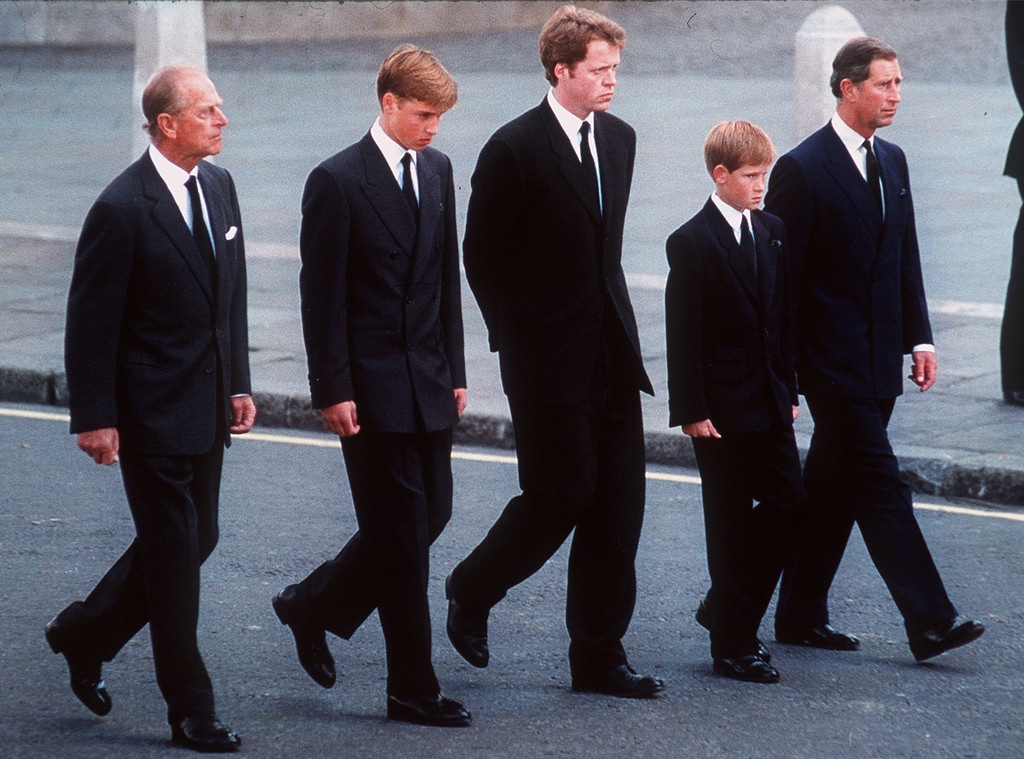
Anwar Hussein/WireImage
“In my opinion, no youngster should ever be asked to perform that task. I don’t believe it would occur now “In 2017, Prince Harry spoke to Newsweek. But he also stated in Diana, 7 Days that, whether it was right or wrong, he was “happy” to have done it.
William continued, “But I have to say, it goes to another level of obligation when it becomes so personal as walking behind your mother’s funeral cortege.
Charles Spencer expressed his strong opposition to the idea of his nephews going on that lengthy, public walk in 2017, telling BBC Radio 4 that the request was “extremely weird and nasty.” At some point, he claimed, “I was misled and told they wanted to do it, which of course they didn’t, but I didn’t recognize that.
He said, “It was very terrible, in fact. It was a very, very difficult moment. “We would walk 100 yards and hear people grieving, and then walk around a corner and somebody would be wailing and shouting out messages of love to Diana or William and Harry.”
Also on that day, Spencer famously used the chance to lash out in no uncertain terms at the forces that, in his opinion, had unofficially worked together to extinguish his sister’s life.
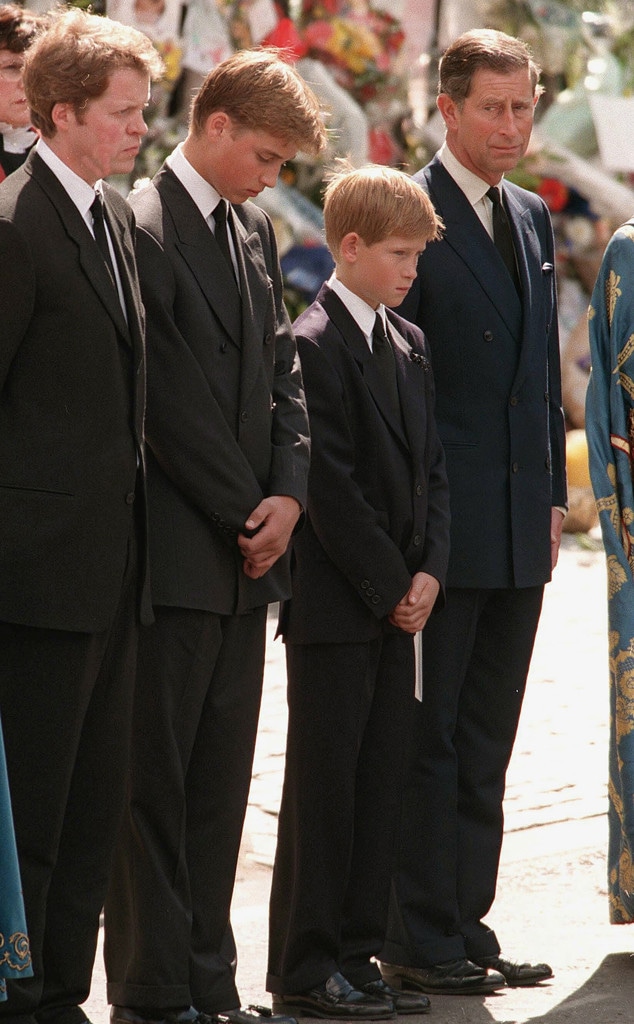
Anwar Hussein/WireImage
“It is a credit to her level-headedness and resilience that despite the most strange existence one could imagine after her youth, she stayed intact, true to herself,” Spencer said in his eulogy at Westminster Abbey. She probably never realized why the media mocked her sincere good intentions or why there seemed to be an ongoing effort on their part to discredit her. It is perplexing.
“My one and only theory is that individuals on the other side of the moral spectrum perceive true virtue as a threat. It’s important to keep in mind that among all the ironies surrounding Diana, this one stands out as the greatest: a girl given the name of the ancient goddess of hunting ended up being the target of the most modern-day hunts. She would have wanted us to promise to guard her precious boys, William and Harry, from suffering a similar tragedy today, and I do this here, Diana, on your behalf. We won’t let them go through the pain that frequently made you cry out in despair.”
In contrast, Diana’s “blood family” would “do all we can to continue the imaginative and loving way in which you were steering these two exceptional young men, so that their souls are not simply immersed by duty and tradition, but can sing openly as you planned.” The Spencers would respect royal tradition, he said.
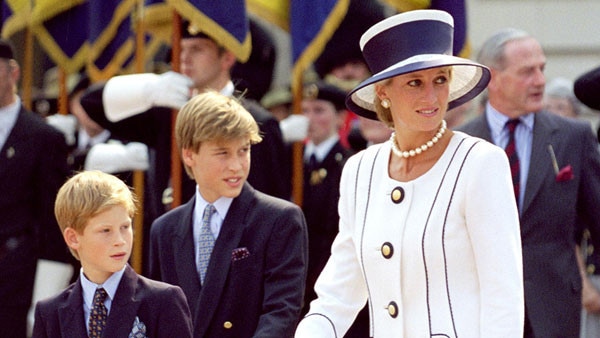
Antony Jones/Julian Parker/UK Press via Getty Images
Spencer told BBC Radio 4 that when the queen was asked about her opinion of his speech by someone he knew well, she responded, “He was completely entitled to express his feelings. It was the funeral for his sister. That’s it, then.” (Tina Brown hypothesized in The Diana Chronicles that Spencer was attempting to rid himself of his own guilt because he was aware that Diana had been upset with him after her death for not granting her a cottage at Althorp—the Spencer family homestead where she was ultimately buried—during her most troubled times, citing the potential disruption from photographers.)
A private letter the queen wrote to her aide Lady Henriette Abel Smith after the funeral and which was made public in 2017 seems to corroborate that the queen’s public remarks about Diana were sincere.
The queen wrote, “It was truly very sad, and she is a great loss to the country. “However, the response to her passing and the service in the Abbey appear to have brought people together in a pretty uplifting way. I am really proud of William and Harry since they have both shown such bravery.” She continued, “I think your letter was one of the first I opened—emotions are still so mixed up but we have all been through a very awful experience,” referring to earlier correspondence from Smith.
The Prince of Wales did not appear publicly for two weeks after the funeral, which was allegedly watched by an estimated 2 billion people worldwide. Charles and his sons sought quiet at Highgrove House.
Diana’s passing also prevented Charles and Camilla’s relationship from developing naturally for months, even though it had been open for some time but had only lately become public. According to Bedell Smith, Charles acknowledged a year later that he was shocked by the public expression of grief and that, although being extremely disturbed himself, “I felt an alien in my own country.”
One of those infamous stiff upper royal lips was speaking there. When Charles returned to the public eye, he responded to a well-wisher who advised him to “keep [his] chin up” by saying, “That’s really good of you, but I feel like sobbing,” despite the fact that Charles has always been known as a more demonstrably sensitive type than either of his parents.
The public’s perception of Charles, who was so frequently painted as the villain in regard to his troubled relationship with Diana, progressively improved as pictures of him as a loving single parent started to surface in the coming months.
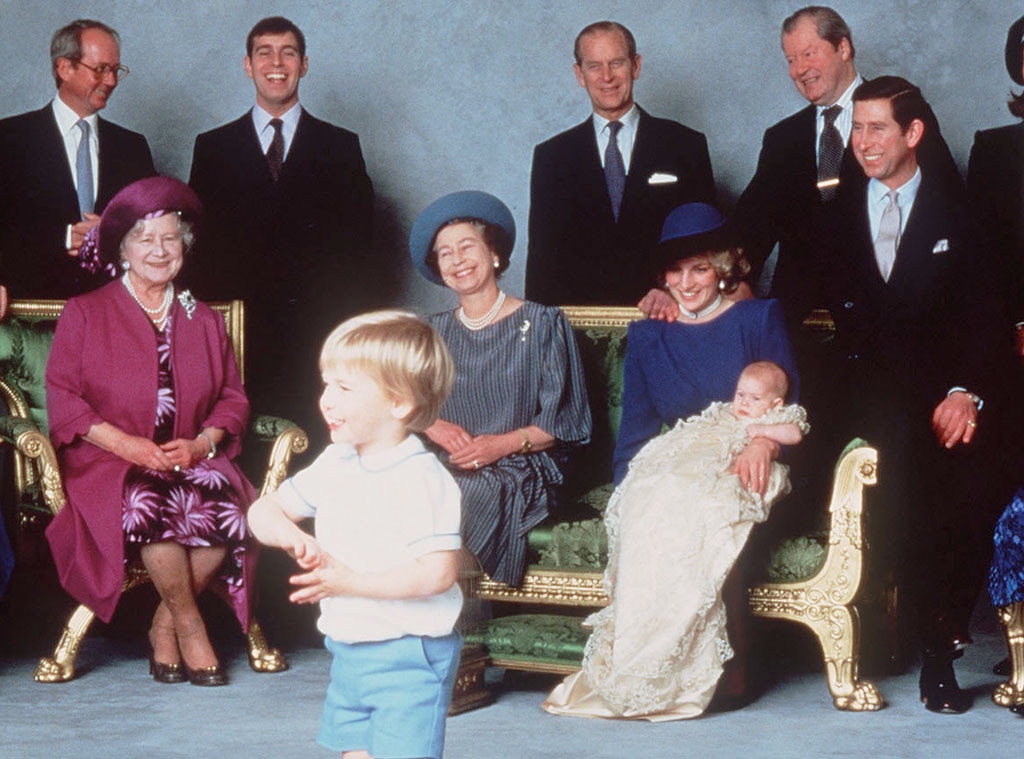
Anwar Hussein/Getty Images
According to Bedell Smith, a rift developed between Charles’ camp and the rest of his family at the same time because Mark Bolland, the Prince of Wales’ deputy private secretary at the time, was subtly ensuring that the media knew that the queen had decided against sending the royal plane for Diana’s remains or holding a public funeral.
The queen’s press office responded by denying that she had ever objected to those proposals. This is not a game where one member of the royal family receives more credit than the other, a palace source told the Daily Telegraph. The mother-son relationship would take some time to warm up, in part because of the queen’s implied disapproval of Camilla, which was made clear by the queen and Philip’s absence from Charles’ 50th birthday party at Highgrove in November 1998.
On a grander scale, though, Charles appeared to be becoming more accepted. During a trip the future king took to South Africa with Harry in November 1997, Charles and his ex-brother-in-law also appeared to have patched things up with the public. Earl Spencer stood up and applauded Charles’ remarks during a state banquet hosted by Nelson Mandela, their first encounter since the funeral.
In his speech, Charles remarked, “The links between our peoples, of which I have spoken, revealed themselves most clearly following the tragic and untimely loss of Diana.” I would want to take this chance to thank all the South Africans who took the time and trouble to send their condolences on behalf of my sons.
Earl Spencer released a statement following the incident, “My connection with the Prince of Wales is cordial. All of my family members are working together to support William and Harry’s upbringing in every way we can.”
The most adored member of the royal family, Queen Elizabeth II, is currently 96 and the longest-reigning British monarch history. However, after the initial days when it appeared that she could be handling Diana’s passing too calmly, there was a lot to unpack.
In addition to adding a Tony to her resume for playing Queen Elizabeth II once more on Broadway in The Audience, a play about the queen’s interactions with a number of British prime ministers over the years, Helen Mirren received an Oscar for her portrayal of the conflicted royal in Peter Morgan’s 2006 film The Queen.
The royal’s true thoughts are known only to heaven.
She has always been really polite, and I’ve met the queen on a few occasions—usually pretty large events with lots of other people there—but she has never mentioned that I’m playing her, Mirren said to Playbill in 2015. “I firmly believe that is appropriate.
“The royal family has always been fairly liberal, and the queen in particular, is from a nation that respects free expression. In spite of numerous films making fun of them, portraying them as Nazis, and abusing them in a variety of ways, they have remained silent. They merely stood by and watched. They don’t stand their ground. There is silence from them. In a way, criticizing that specific world is not their job. The same is true of a movie that I am aware the queen’s entourage enjoyed, but she would never publicly acknowledge.”
In the movie The Queen, Tony Blair (Michael Sheen) calls the queen at Balmoral and inquires as to whether or not she believes that an early return to London would be in the best interests of the populace.
The queen played by Mirren responds, “I doubt there is anyone who knows the British people more than I do, Mr. Blair, nor who has greater faith in their intelligence and judgment. “And I think they’ll soon reject this… this atmosphere that the media is creating in favor of a period of constrained grief and somber, quiet grieving. Our is how we conduct ourselves in this nation—quietly and with grace. The rest of the world has always admired us for doing that.”
Add that incident as another example of how Diana’s departure from the royal family irrevocably changed how incorrect the queen was.

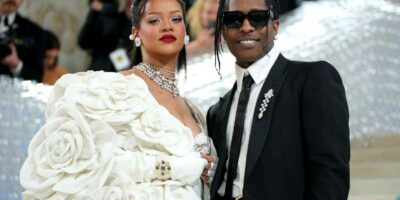


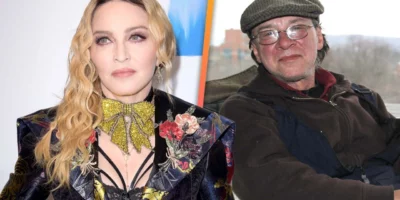
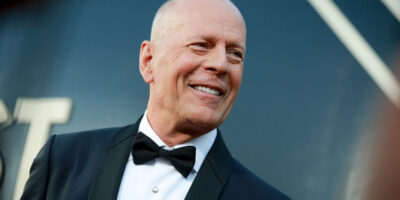











Comments